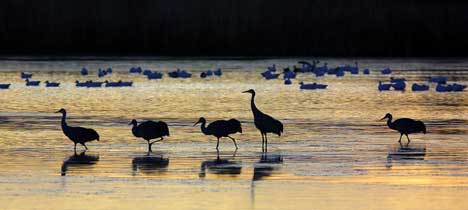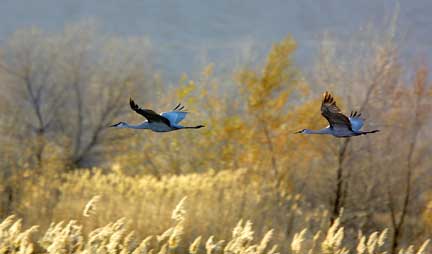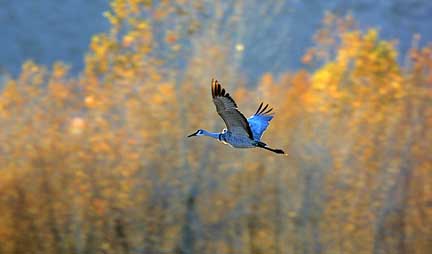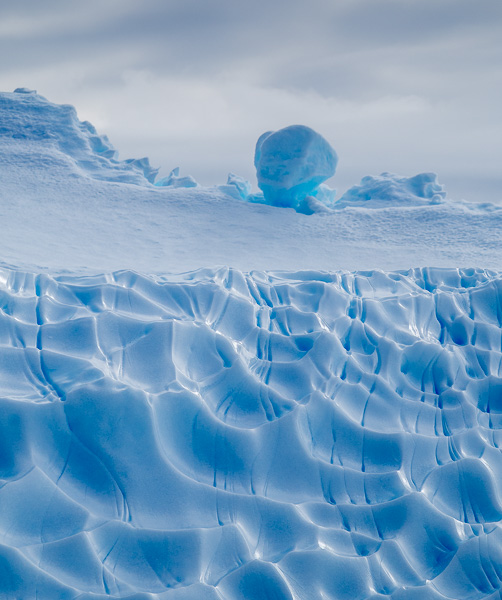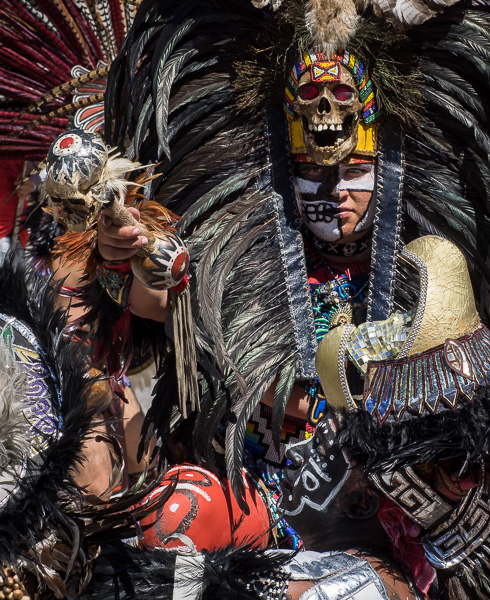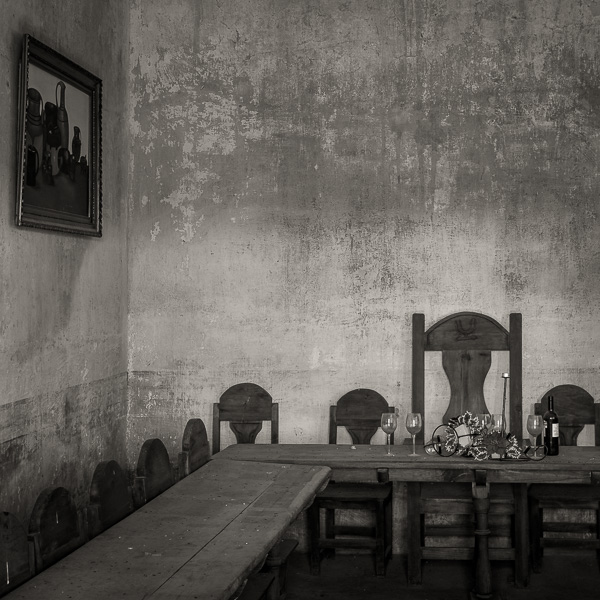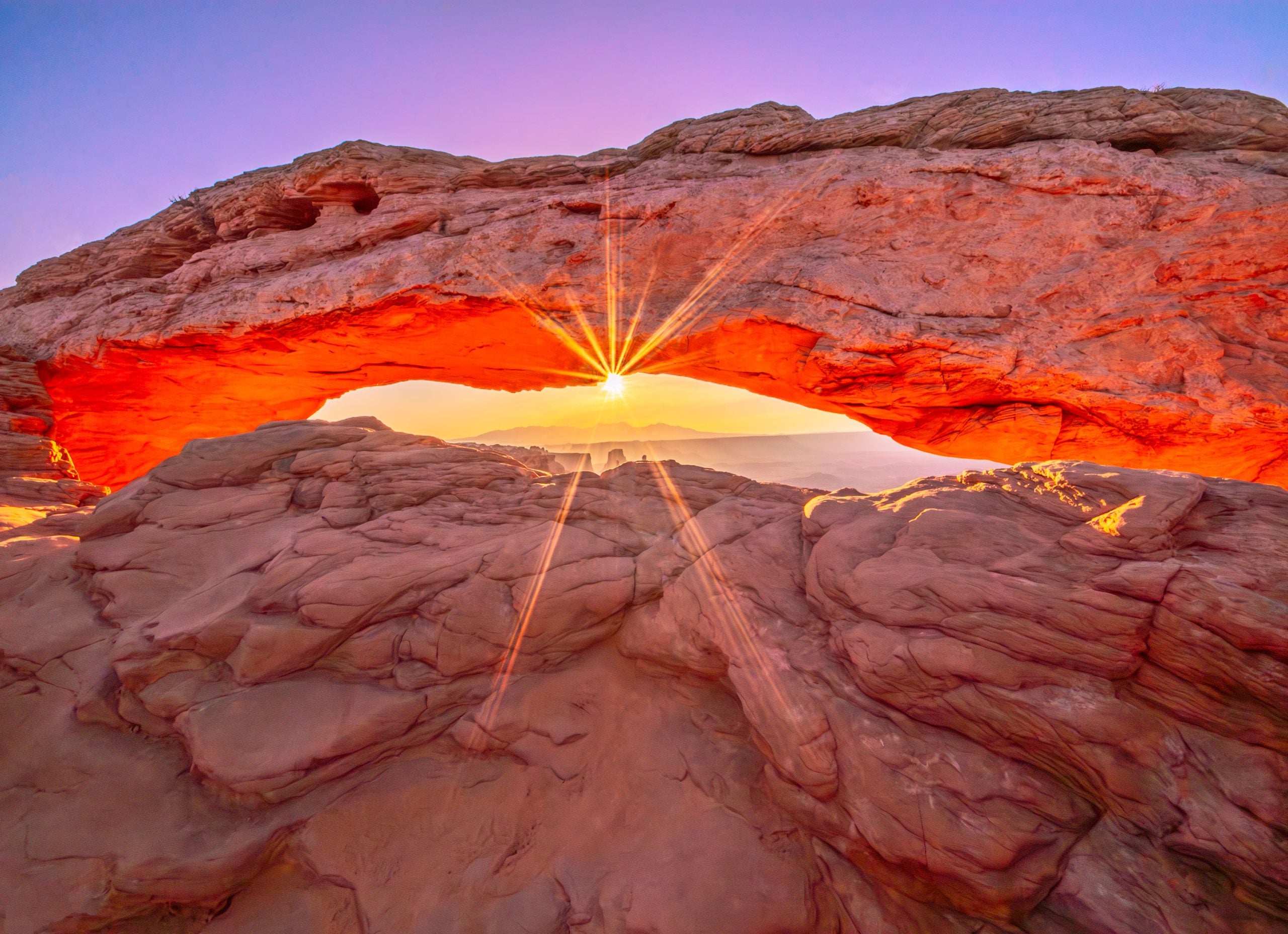Canon 400mm f/4 IS DO Lens
Super Telephoto
Canon D30 @ ISO 100 using a 400mm f/4 IS DO lens. 1/800 sec @ f/5. EFL= 640mm
Canon Canada loaned this exciting new lens just a few days before my leaving for a wildlife shootatBosque Del Apachein New Mexico‚ one of the premier locales for shooting Sandhill Cranes and Snow Geese in North America. This review is therefore divided into two sections: The first consists of some static tests and comparisons done prior to the trip, and the second contains photographs and impressions made during the shoot at Bosque.
To my knowledge this is the first hands-on review of a production Canon 400mm DO lens to appear anywhere in the world.
This field review is featured in an extensive video segment inIssue #3ofThe Luminous Landscape Video Journal.
This page contains a number of large test images and samples, therefore it will load slowly unless you have a high-speed Internet connection. Be patient. It’s worth it.
Technical Note:Because many of the photographs in this review were done with aCanon D30which has a magnification factor of X1.6, and also with a 1.4X Extender, I have noted theEffectiveFocalLength (or EFL) of the lens used. This will help give you an idea of the equivalent focal length on 35mm film.
Ultra Small‚ Ultra Light
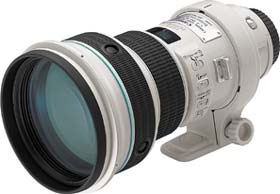
This revolutionary lens was first shown atPhotokinain September of 2000. It was supposed to ship in the first half of 2001 but was delayed until December. According to Canon the new EF 400mm f/4 DO IS USM is 26% shorter and 36% lighter than a conventional lens with the same focal length and aperture specifications.
That’s the good news. The bad news is that the lens has a manufacturers’ suggested retail price of U.S. $8,900‚ which likely means a retail price of about $6,000. Whew! Canon’s 400mm f/2.8L IS lens sells for about $1,000 more, but is a stop faster and much heavier and larger.
If you can live with f/5.6, and don’t need the IS technology, you can buy Canon’s 400mm f/5.6 lens for only $1,000. Another comparison is that this lens is about the same price as Canon’s 500mm f/4L IS lens. Longer focal length, same speed, IS technology, butmuchbigger andmuchheavier.
Quite a difference whichever direction you turn. As the saying goes, "You pay your money and you take your chances." Let’s see what your money gets you in this case.
The Technology

The big news here, and what allows the lens to be so much smaller and lighter than anything comparable is the use ofDiffractiveOptics; specifically the use of what Canon calls "the Multi-Layer Diffractive Optical Element’s diffraction grating".
Let’s decode the bafflegab. If you want all the gory details there’s an excellent write-up atdpreview.comfrom when the lens was first announced. Here’s the short version…
"To make a lens smaller and lighter, the spacing between the elements is shortened and the refractive properties of the front and rear lens groups become more pronounced. This, however, results in increased chromatic aberration. To resolve this problem, the Multi-Layer Diffractive Optical Element is located within the lens to cancel out the occurrence of chromatic aberration.
By combining a Multi-Layer Diffractive Optical Element and a refractive optical element within the same optical system, chromatic aberration (color smearing), which adversely affects image quality, can be corrected even more effectively than with a fluorite element. Also, by adjusting the pitch (spacing) of the diffraction grating, the diffractive optical element makes possible the same optical characteristics as a ground and polished aspherical surface, which effectively corrects for spherical and other aberrations."
Got that?
First Impressions

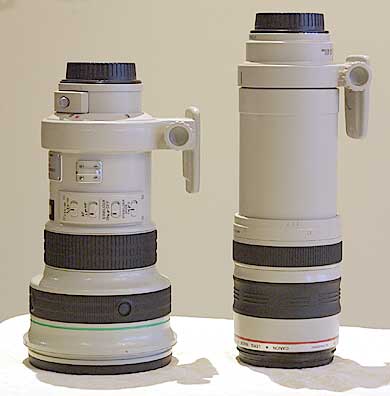
Ones first impression of this lens is coloured by whether or not one owns or has used one of Canon’s other Super Telephoto lenses. As the owner of Canon’s300mm f/2.8L ISlens I was amazed at how small and light the 400mm DO was by comparison. On the other hand a colleague who has never used one of the big telephotos before was impressed with howbigthe DO was when seen compared to more typically sized lenses. Everything is relative I suppose.
The photo above at left shows the 400mm f/4 DO next to the 300mm f/2.8L IS. Yes, thesmallerone is the 400mm. Remarkable. The frame at right above shows the 400mm f/4 DO next to the Canon 100~400mm f/5.6L IS zoom, with the zoom extended to its 400mm position.
Some Comparisons
My approach to testing new lenses is much the same as that of other photographers. I’m most interested in how it performs in the field, but can’t resist the temptation to do some comparisons with lenses that I’m already familiar with. I’mnotespecially interested in shooting lens resolution charts. I leave that to others.
Testing the 400mm DO was a bit of a challenge though. It was being loaned to me for just one week. The good news was that 4 days of the 7 would be spent on a wildlife shoot atBosque del Apachein New Mexico‚ an ideal venue for becoming familiar with a new long lens. The bad news was that, excluding two travel days, this left me with just one day to do some static tests, and that day it turned out was on a bleak, cold, rainy late November morning.
Given that I wanted to compare the 400mm f/4 DO to both the 300mm f/2.8L IS and also the 100~400mm f/5.6L IS zoom, and I was also at the same time testing the new70~200mm f/2.8L ISagainst its predecessor, I had a pretty hectic time of it. Because of the logistics and bad weather my testing venue ended up being my back yard, with some faded plants at the end of the garden becoming my test subject.
This shot is full frame @ 400mm of the test subject. I won’t repeat any more full frame images because frankly, they all look much the same at this on-screen size. You can see an enlarged version by clicking on the picture.
I shot this scene with three lenses‚ the 400mm f/4 IS DO, the 300mm f/2.8L IS (moved closer so that the image size was the same as with the 400mm lens), and the 100~400mm f/5.6L IS zoom set at 400mm. I did frames with each camera at f/4, f/5.6 and f/8, (the zoom only at f/5.6 and f/8 because its maximum aperture is f/5.6).
The camera used was aCanon D30set at ISO 100. The lenses were each mounted directly on aGitzo 1349carbon fiber tripod using anArca Swiss B1head. The camera body was then mounted on the lens. Shots were taken with IS mode both turned on and off.
Before anyone jumps in and says, "Ya but…", wanting to criticize me for using a digital SLR rather than film, just let me say that over a 2 hour period I shot more than 100 frames. To then have had to scan each of these would have been tiresome at best and in any event would have taken far more time that I could expend. (Also, while high-res scans would have shown more detail, they would have shown more detail onallimages from all three lenses. I therefore feel that the playing field is level.)
Finally, I examined each frame at 100%, "Actual Pixels" magnification. I carefully compared both center and edges. I made extensive notes of the results. What you see below is abriefsummary of those test notes anda fewsample images along with my judgment of each lens’ performance under these test conditions.
Incidentally, the minor colour and brightness variations seen below are simply due to my inability to exactly match the images given the time available. Don’t judge the colour rendition of the lenses from these tests.
Wide Open
 400mm DO @ f/4
400mm DO @ f/4
 300mm IS @ f/4
300mm IS @ f/4
 100~400mm IS zoom @ f5.6
100~400mm IS zoom @ f5.6
The two big primes are essentially identical in performance though the 300mm lens appearsslightlysharper than the 400mm DO. (At f/4 the 300mm lens is stopped down 1 stop, so I’m not really surprised). The 100~400mm zoom is significantly less sharp than the other two when used wide open (f/5.6). Since the 300mm f/2.8L IS is regarded by many asthebenchmark high-speed telephoto lens, and in my experience is one of the sharpest lenses I’ve ever seen, this is exceptional performance from the DO lens.
With both prime lenses edge sharpness at various apertures pretty well tracks that of the lens’ centers.
![]()
Since this review first appeared a number of people have written to express their concern about the results from the 100~400mm lens. Some have questioned whether the lens was properly focused and even whether my particular lens has a problem.
Let me first point out that yes, the lens was properly focused. Also, this particular lens has been my most used for wildlife work for the past two years. I’ve produced some extremely fine results with it. But, it really isn’t in the same league as either the 400mm DO or the 300mm f/2.8 when used wide open. When one is paying $5-$6,000 for a prime super-telephoto one is getting a very sharp lens indeed and the ability to extract that performance even at full aperture.
Finally, please note that the three frames above are 100% actual pixel enlargements‚notfull frames. The full frames were the size as seen at the top of the section.
At f/8
I examined all three lenses, center and edges, at f/8 as well. The 400mm f/4 DO and the 300mm f/2.8L IS appear essentially identical. Unless I looked at the frame identification I couldn’t tell them apart. (Remember, framing is slightly different because I had to move the camera to match image size between the lenses because of their different focal lengths.)
The 100~400mm zoom was simply not in the same league, even closed down 2 or 3 stops.



400mm f/4 DO 300mm f/2.8L IS 100~400mm f/5.6L IS zoom
Static Test Evaluation
I won’t bore you with more comparison frames to peer at and ponder. It was clear from these tests that the newCanon 400mm f/4.0 DI ISlens a superb optic, fully the equal in terms of image quality of Canon’s other super-telephoto lenses. No, I didn’t conduct a complete lab test‚ I’ll leave that to someone with both an optical lab and the inclination. What I was able to establish after several hours of blurry eyed examination of screen and prints was that I would be able to take this lens into the field with complete confidence that the images I would bring back would be as good as the lens maker’s art is currently capable of, (and at a street price of more than US $6,000, it better be!)
Minor Observations
Though in terms of price, features, performance and optical quality this is one of Canon’s top lenses, it is not designated as an "L" series lens. It thus doesn’t have the red ring around the lens barrel that all L lenses do. Instead its designation is DO and it has a green barrel ring. Apparently this is destined to be the first of a new line of lenses with its own designation and cosmetics. Just thought you’d like to know.
Otherwise the 400mm f/4 DO IS is a clone of Canon’s other top IS super-telephoto lenses, with moisture and dust resistant rubber lens mount seal for use with the 1V and 1D models. It has the common Canon super-telephoto slot-type 52mm filter holder near the lens mount and buttons around the front end of the lens that can be programmed for various applications.
I was curious to see if the diffraction element was in any way visible, and indeed it is, but not directly. If you hold the front element up to the light and rock it back and forth you can see a ringed diffraction pattern. Also, this diffraction pattern is noticeable in the viewfinder as aslightcoarsening of the ground glass‚ likely as a result of interference with the fresnel rings on the focusing screen. Nothing bothersome, but there. Of course it is not in any way visible in the final image.
Like the 300mm f/2.8L IS, the 400mm f/4 DO IS comes in a fitted hard plastic case that looks like a ladies cosmetic case, and which has Canon insignia blazoned upon it. What are they thinking of? All this case is good for is storage. No photographer would consider traveling or working on location with one of these. It might as well have "Steal me! I’m an expensive lens," written all over it.
In the Field
Enough theory and back yard testing, what’s the performance really like and how does it handle in the field? Three days atBosque del Apachetold the tale. Incidentally, while shooting there I was alongside a number of serious wildlife photographers equipped with Canon400mm f/2.8 ISlenses. I felt like I was using a toy by size comparison, yet their monster lenses were only a stop faster, and no longer.
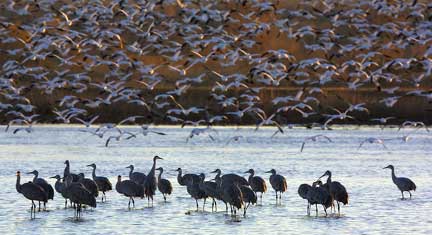 Birds of a Feather‚ Bosque del Apache
Birds of a Feather‚ Bosque del Apache
Canon D30 @ ISO 100 using a 400mm f/4 IS DO lens. 1/250 sec @ f/5.6. EFL= 640mm
How did it perform? In a word, superbly. I can’t fault this lens in any way. To have a an ultra-high quality large aperture 400mm lens in a size smaller than that of a super-300mm is a pleasure when working in the field. While I used the lens tripod mounted, using aWimberley Sidekickgimbal mount 95% of the time, when I did hand-hold it the savings in weight were really appreciated. Having to fly to the location also made the smaller length and bulk welcome when laying out my backpack.
Canon D30 @ ISO 100 using a 400mm f/4 IS DO lens. 1/800 sec @ f/5.6. EFL= 640mm
I spent a good 15 minutes one morning hand-holding the lens on a series of grab shots of cranes in flight. The image above is slightly soft because the D30’s dreadful autofocus was turned off, and my manual focusing wasn’t perfect. Still, I doubt that I could have hand-held a larger 400mm lens for this long.
Canon D30 @ ISO 100 using a 400mm f/4 IS DO lens. 1/250 sec @ f/5.6. EFL= 640mm
The "bokeh", or characteristics of the out-of-focus portion of an image, is considered by many (me included) to be of great importance in defining the "signature" or characteristics of a lens. In the frame above, where I was focused on the foreground vegetation and the line of cranes was allowed to go soft, they have a very lovely soft-edged quality. Good bokeh, as the Japanese would call it.
Canon D30 @ ISO 400 using a 400mm f/4 IS DO lens with 1.4X extender. 1/250 sec @ f/5.6. EFL= 900mm
Canon D30 @ ISO 400 using a 400mm f/4 IS DO lens with 1.4X extender. 1/100 sec @ f/5.6. EFL= 900mm
These two frames were shot while rapidly panning the lens on a Wimberley gimbal mount. The birds were at a great distance and flying very quickly‚ coming in for a landing. As noted, these were shot at an effective focal length of 900mm because I was shooting with a 1.4X Extender as well to the D30’s 1.6 multiplication factor. Alonglens any way you figure it.
The birds are incredibly sharp, and no, the image is not over-sharpened. The reason that it might look that way is that these were taken just before sunset, with the sun directly backlighting the birds‚ this creating the edge effect.
Frankly, I’m blown away at how well the 400mm and the Canon 1.4X did together.
Flare‚ What Flare?
I was approached at one point in Bosque by a photographer who said that he’d heard that this lens concept was susceptible to flare. Later than day I found myself shooting almost directly into the setting sun (the two frames immediately above are part of that sequence) and didn’t see any unusual flare characteristics. On the other hand, I wasn’t testing for it. I no longer have the lens available to me so I can’t test this further. Not an issue as far as I can see.
Who’s It For?
This is for me the toughest question of all. This first DO lens is without a doubt a technological tour-de-force. Undoubtedly it is expensive because it’s the first of its type. If this technology proves out, we will no doubt see it applied to a broader range of super-long lenses, and we’ll consequently see prices fall over time.
But for now anyone contemplating the purchase of this lens really has to have a very strong need for light weight and compactness over either low price, a faster aperture or a longer focal length. Like I said, "You pay your money and you take your chances." But after this review, hopefully a bit less of a chance.
If you get a400mm DO IS, let me know how you like it and send me some sample images.
![]() December 21, 2001
December 21, 2001
A few days agoCanon Germanyposted a PDF file of their "Profile" newsletter. One of the sections featured the400mm f/4 DOISlens. But, at the bottom of the article was a mention that there were two moreDO ISlenses coming‚ a500mm f/2.8 DO ISand a200-400mm f/4 DO ISzoom.
This announcement quickly caused a flurry of excitement on online forums, but within less than a day the article had been revised to remove any mention of these two lenses. Clearly a mistake had been made. It either was an ad agency copywriter inventing some new products, or much more likely an inadvertent slip.
As I said above, no doubt there are moreDOlenses coming. These particular two would be doozies.
There is aweb pageonline that shows the original text as published as well as the revised version. Time will tell.
![]() February, 2002
February, 2002
AmateurPhotographerTest Report
In theJanuary 12, 2002issue of the British magazineAmateur Photographerthere is a test report on the 400mm DO lens. I found this to be of particular interest because the magazine’s optical bench test results jibe very well with my own field experience.
They report that the lens is capable of 120 lp/mm at high contrast and over 90 lp/mm at low contrast. This ranks the lens among the finest ever tested. In every other measurable parameter the 400mm DO test scores are exemplary, with vignetting at less than 1/4 stop wide open and essentially gone by f/5.6. Resolution at center and edges was found to essentially the same from wide-open to f/16. Really excellent results.
Now if only Canon would lower the price.
This field review is featured in an extensive video segment in
Issue #3ofThe Luminous Landscape Video Journal
If you enjoyed this article, as well as the hundreds of other tutorials, features,
reviews and essays on this site, you can support its continued growth
and discover an exciting new photographic resource by …
Read this story and all the best stories on The Luminous Landscape
The author has made this story available to Luminous Landscape members only. Upgrade to get instant access to this story and other benefits available only to members.
Why choose us?
Luminous-Landscape is a membership site. Our website contains over 5300 articles on almost every topic, camera, lens and printer you can imagine. Our membership model is simple, just $2 a month ($24.00 USD a year). This $24 gains you access to a wealth of information including all our past and future video tutorials on such topics as Lightroom, Capture One, Printing, file management and dozens of interviews and travel videos.
- New Articles every few days
- All original content found nowhere else on the web
- No Pop Up Google Sense ads – Our advertisers are photo related
- Download/stream video to any device
- NEW videos monthly
- Top well-known photographer contributors
- Posts from industry leaders
- Speciality Photography Workshops
- Mobile device scalable
- Exclusive video interviews
- Special vendor offers for members
- Hands On Product reviews
- FREE – User Forum. One of the most read user forums on the internet
- Access to our community Buy and Sell pages; for members only.






